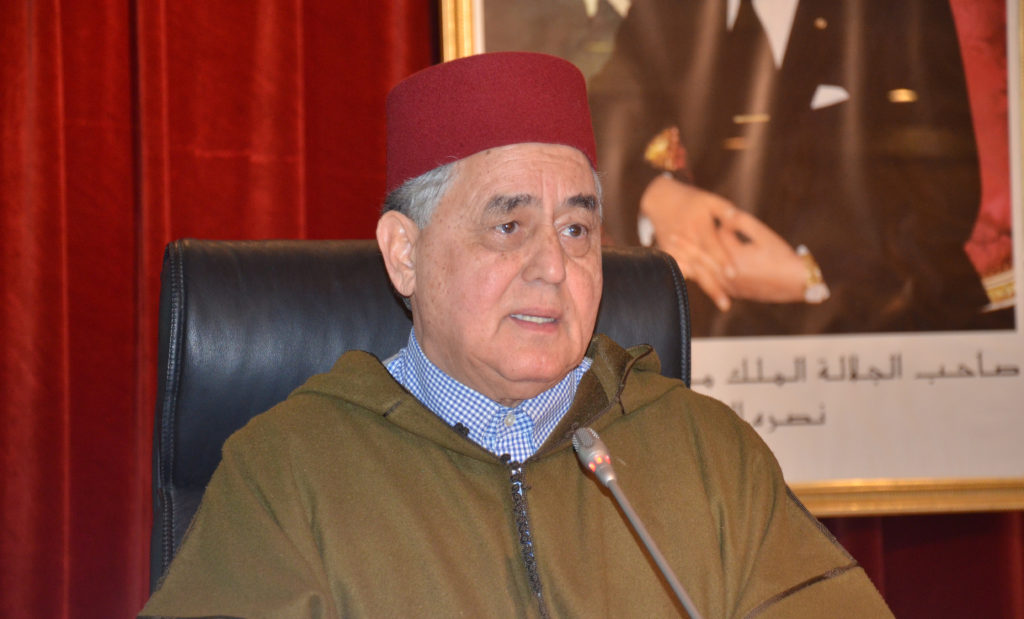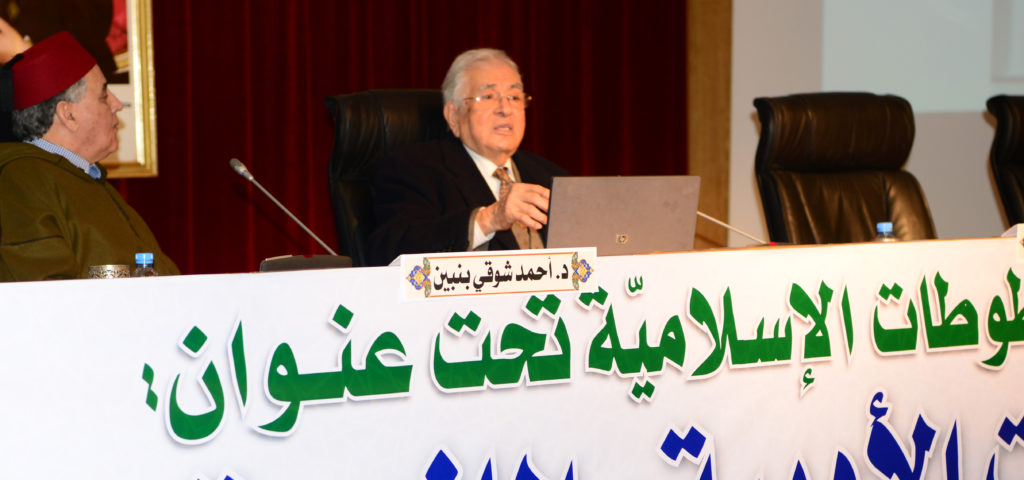On Monday, 4 March 2019, in the lecture theatre at Dar al-Hadith al-Hassania Institute in Rabat, a public lecture titled “Critical edition of Kitāb al-‘Ibar by Ibn Khaldūn: plan, vision, and results” was delivered by Professor Ibrahim Chabbouh. This lecture—organised by the Centre for Study of Islamic Manuscripts at Al-Furqān Islamic Heritage Foundation—was distinguished by the attendance of a large number of scholars, doctoral students, researchers, and representatives of cultural bodies.
The event was chaired by Professor Ahmed Chouqui Binebine, Director of the Bibliothèque Royale (al-Khizānah al-Malakiyyah) in Rabat, and member of the Board of Experts at the Centre for Study of Islamic Manuscripts at Al-Furqān Foundation. At the outset, Professor Binebine offered a synopsis of the lecture topic, and summarised the lecturer’s lifetime scientific achievements.

The lecturer, Professor Ibrahim Chabbouh, reflected on his extensive experience, stretching over three decades, spent critically editing Ibn Khaldūn’s renowned text on history titled Al-‘Ibar wa dīwān al-mubtada’ wa al-khabar fī ayām al-‘arab wa al-‘ajam wa al-barbar wa man ‘āṣarahum min dhawī al-sulṭān al-akbar.
Professor Chabbouh began by exploring the influence of historical events on Ibn Khaldūn, focusing on how these shaped the authorship of this grand work. Key highlights covered in the lecture related to the following events and their influence:
Most of the book’s content and records pertaining principally to the Berbers, and their fusion with the Arabs was gathered during the author’s formative years in Tunis, where he was witness to the influence of Banū Hilāl. It was closely followed by material collated during the Maghreb phase, where he was in close proximity to the affairs of sovereign nations, and participated in both the public and private aspects of state. The book’s compilation phase began in 776AH when he secluded himself in the Banū Salāmah Citadel in Taghzout, where he resided for four years (until 780AH).
He was then obliged to search for sources for his work that were only to be found in the urban centres of the time. He therefore returned to Tunis, where Abū al-‘Abbās Aḥmad al-Ḥafṣī invited him to complete the work. Consequently, in around two years, he wrote what he called Turjumān al-‘Ibar, which he gifted to Abū al-‘Abbās Aḥmad al-Ḥafṣī, and furthermore, recited his panegyric lāmiyyah ode, dedicated to his patron, to mark the occasion.

He then migrated to Egypt for his own reasons, where he was honoured by being employed in its Madrassahs and the Khānqāh, and subsequently served several times as a Mālikī school of jurisprudence judge. He was then appointed Chief Justice (Qāḍī al-Quḍāt), while at the same time, he continued to teach Islamic jurisprudence (fiqh), and his Muqadimah – as al-Sakhawī reported.
In 791AH, he faced a huge political test that caused him to retire to Ceuta, and go about revising his work, al-Tārīkh, by adding the part on “al-‘ajam” or the non-Arabs, after it had been limited to the Arabs and Berbers (the term, “al-‘ajam” refers to all those non-Arabic-speaking Muslim peoples). As such, the entire map of the Muslim world was now at his fingertips, and he dwelt profoundly on the description of its people’s conditions. Indeed, he produced novel and significant results in the classification of Islamic history, namely that: the Islamic state was founded on the four Rightly-Guided Caliphs, where Mu‘āwiyyah could rightly be classed among them, had he not been excluded by virtue of becoming one of those caliphs dominating by force (mughālabah), rather than people’s choice. Furthermore, Mu‘āwiyyah also established a hereditary caliphate, in the like of monarchs and Roman Caesars. This marked the starting point for conflict and dispute, with the development of a new concept that the caliphate must be restricted to the descendants of Prophet Muḥammad, called Āl-al-Bayt.
This conflict persisted until 136AH, when Banū al-‘Abbās’ supporters prevailed, taking control of the caliphate. From that moment, the Muslim nation was divided into three: (i) Banū al-‘Abbās and those independent states aligned to them by virtue of recognising them, and thus established their government within their orbit, even if by association—these were denoted by Ibn Khaldūn as “duwal al-tabi‘ah” or client states; (ii) those who considered themselves closest in lineage to Āl-al-Bayt, and hence, believed themselves to be more worthy of the caliphate, i.e. the Alawiyyūn, represented by the Adārisah, Zaydiyyah, Fatimiyyūn, Qarāmiṭah, etc., which he denoted “al-muzāḥimūn” or jostling competitors; and (iii), the Ummayads of al-Andalus, who had previously controlled the caliphate, which he termed “al-munāzi‘ūn” or disputers. He organised the book’s chapters, based on this perspective, in a way that contrasted to the approach of all the historians in their general histories.
In the second aspect of his lecture, Professor Chabbouh expanded on his long experience in collecting and studying copies of Kitāb al-‘Ibar. He pointed out that, over the span of 35 years, he had found more than 300 extant pieces of the book in both public and private libraries in the East and the West. Indeed, some of these carried corrections, commentary, and annotations in the author’s own hand. He had subjected these to deep codicological examination, extracting countless subtle points (nukat) and useful remarks (fawā’id), and mapping the relationships between these surviving texts in an elegant way. He also pointed to the praiseworthy effort dedicated to transcribing the book correctly from original texts, with precise collation of manuscripts, while preserving the novel approaches devised by Ibn Khaldūn. These included illustrating the genealogy of the states and the tribes he mentions in the work, and creatively inventing letters that represented non-Arabic phonetics, as needed by non-Arab and Berber words. All these were preserved by the editor in his polished publication of the critical edition, which he also enriched with brief, beneficial, and intellectually stimulating comments.
After the lecturer concluded his presentation, extensive discussion ensued, with important questions posed on those topics raised in the lecture.



